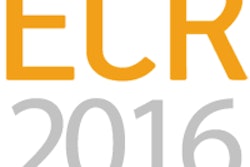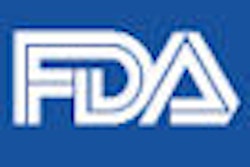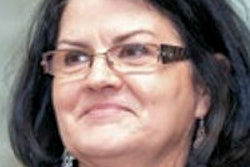
While the interminable wait continues for U.S. Food and Drug Administration (FDA) approval of ultrasound contrast agents in radiology applications, the delay doesn't preclude their clinical use now in the U.S., according to a presentation at last week's American Institute of Ultrasound in Medicine (AIUM) meeting.
With the proper precautions, off-label use of ultrasound contrast agents allows institutions to provide this clinically valuable technique for patients in a range of clinical applications, according to Dr. Richard Barr, PhD, a professor of radiology at Northeast Ohio Medical University.
"We have used it routinely and have done so for over a decade," he said at the Las Vegas meeting. "I would really encourage you to use this, especially if your practice has situations where this would be very helpful."
 Dr. Richard Barr, PhD, from Northeast Ohio Medical University.
Dr. Richard Barr, PhD, from Northeast Ohio Medical University.
Ready for routine use
Contrast-enhanced ultrasound (CEUS) can be used routinely and should be considered when it can help a patient, such as those who are renal-impaired but require contrast, or patients with allergies to CT and/or MRI contrast. It could also be used when CT or MRI does not answer the clinical question or yields conflicting information, or when it's important to know that no flow is present, such as after radiofrequency ablation studies, Barr said.
Types of exams that are good candidates for CEUS include those in the liver (particularly for focal nodular hyperplasia) and kidney (for indeterminate renal masses), aortic stent grafts, small bowel studies, and other studies where contrast could also be used with CT or MRI.
"In selected patients, [CEUS] has made a big impact in the way we treat patients for diagnosis and/or outcome," he said.
According to the FDA, if physicians use a product for an indication that's not in the approved labeling (i.e., off label), they are responsible for being be well-informed about the product, for basing its use on firm scientific rationale and sound medical evidence, and for maintaining records of the product's use and effects, Barr said.
Using a marketed product in this manner when the intent is the "practice of medicine" does not require the submission of an investigational new drug (IND) application or investigational device exemption (IDE), or review by an institutional review board (IRB).
"However, some universities may require that any off-label use go through their IRB," he said.
Clinical advantages
Ultrasound contrast offers a number of clinical advantages, such as real-time assessment of vascularity, according to Barr.
"It is a true intravascular agent," he said."So there is a little difference from CT and MR, where there's extravasation of contrast in the later phases."
Ultrasound contrast also doesn't lead to renal or liver impairment. The agents have a short half-life of approximately five minutes, and multiple injections can be performed. No ionizing radiation is used in the studies.
As for disadvantages, CEUS requires starting an IV, and two people are needed to perform the exam. Also, CEUS generates a lot of data, and PACS issues need to be considered, Barr said. At his institution, three-minute clips are saved to a USB-connected hard drive; only selected images are sent to the PACS.
CEUS requirements
Contrast ultrasound requires the presence of contrast-specific software on an ultrasound system, a contrast agent, IV access, and two sets of hands (one to scan and one to inject the contrast).
Barr noted that all major ultrasound vendors have contrast-specific software available for sale outside the U.S. However, vendors have varying policies about whether contrast applications can be activated in the U.S. for radiology applications.
"You have to have your manufacturer turn on your contrast-specific software, which is probably on your machine but not turned on," Barr said. "Most vendors are now willing to turn this on for you."
Institutions must use an agent that has been approved for an indicated use in the U.S. That means they have only two options right now, both designed for cardiac imaging: Optison (GE Healthcare) and Definity (Lantheus Medical Imaging).
"Actually, if your cardiologists are doing this in their lab, your pharmacy probably already has it in the hospital," he said.
Performing CEUS
After a patient is selected for CEUS and the exam is discussed with the referring physician, the patient can be asked to provide informed consent before the exam. This isn't necessary, however, unless the study is being performed for research, Barr said. At his institution, patients sign a brief informed consent document stating that they are receiving a drug approved for cardiac use in the U.S., and that the same dose, power output, and method of injection are being used.
An IV is then started on the patient. At least a 20-gauge needle should be used so that the ultrasound contrast bubbles are not broken, he said.
Barr recommends that a three-way stopcock be considered, with contrast in one port in line with the needle and saline flush in the other port at 90º to the needle. Caution must be exercised, as high pressure can burst the bubbles, he said.
Prior to injection, both Definity and Optison need to be activated to form the active bubbles. "Once activated, care should be taken not to induce pressure changes that burst the bubbles," Barr said.
A standard ultrasound exam is performed, including identifying the lesion or area of interest. Then, an imaging plane should be found that ensures that the lesion remains in the field-of-view during the patient's breathing.
After the contrast-specific software is activated and, if desired, the dual-screen display mode on the scanner is launched, the contrast agent should be injected, Barr said. Both Definity and Optison have a usual dose of 0.33 cc, and a 1-cc syringe is recommended. Some organs such as the breast that have decreased blood flow or require the use of higher frequency transducers may need a double dose. It's important that contrast injection be quickly followed with a 10-cc saline flush to get the agent into the venous system.
While one person is injecting the drug, the sonographer starts a timer and begins video-clip acquisition, according to Barr. If desired, the ultrasound scanner's optimization button can be used, but this will change the image appearance of the contrast.
"If you're going to do some dynamic studies or quantitative work, you have to make sure that you do not use the [optimization feature] during the scan," he said. "You can use it initially and you may have to modify either the B-mode or the contrast to make [the study] look right, but in general the settings that are on the machines and the presets work extremely well."
Next, it must be decided if an additional contrast dose is required. It's a good idea to have a physician present during scanning to make this determination, according to Barr.
Selected images are then saved and sent to the PACS for review. At this point, the study is complete and the IV is removed. Reporting of the study should include the number of injections, the doses, and the agent.
Billing
Unfortunately, no additional reimbursement is available at the moment for CEUS procedures performed in the hospital setting. Office settings can receive Medicare reimbursement for use of the contrast agent with the Q9957 Healthcare Common Procedure Coding System (HCPCS) code, Barr said.
There isn't a CPT code at this time for ultrasound contrast in the abdomen, although a lobbying effort is underway to spur the American College of Radiology to start one. In the meantime, there is no reimbursement for the additional effort of a contrast ultrasound scan. Billing can be performed only for the standard noncontrast study.
Institutions cannot get help from drug companies or equipment vendors for off-label use of contrast agents. However, companies can respond to specific questions if asked, according to Barr.
The International Contrast Ultrasound Society (ICUS) is a good source of educational material, and training courses are also offered in Europe, he added.
Those interested in performing research involving CEUS will need to obtain IRB approval. Drug companies and vendors may provide a grant if they are interested in the study, and they can provide support if you have an IRB.
It's still uncertain when ultrasound contrast agents will be approved in the U.S. for radiology applications, Barr said.
Nonetheless, "the rest of the world has had these for many, many years and they have an extremely excellent safety record," he said. "You should not feel uncomfortable doing these as off-label because we think we've made a significant impact on our patients by using this in our practice."
He cautioned, though, that it's important to gain a more detailed understanding of physics and interpretation of ultrasound contrast studies before beginning to perform them.




















